Military
At the outbreak of WW1 the War Office commandeered the newly built 5-storey warehouse for the H.M. Stationery Office in Stamford Street and Cornwall Road for use as a Red Cross military hospital. Within a fortnight, by December 1914, all 1650 beds had been subscribed for - at a cost of £25 per bed - thus raising £41,250. Queen Alexandra, the mother of King George V, had provided the first one.
Reputedly the largest hospital in the United Kingdom, the King George Hospital finally opened at the end of May 1915 (labour disputes and strikes had delayed its opening). The first convoys of wounded men were brought by boat train to Waterloo station nearby (tunnels built as an integral part of the warehouse connected the building to the station so as to facilitate movement of supplies, and these enabled badly wounded men to be conveyed to the Hospital out of sight of the public). Some 200 men a day were admitted over three days to the two uppermost ward floors, whilst carpentry work continued on the lower floors.
The War Office had been responsible for the structural alterations to the building, while the British Red Cross Society and the Order of St John equipped the wards, operating theatres, dispensaries, special departments, chapel, day rooms for the patients and sleeping quarters for the staff, all paid for by the generosity of the British public. The British Farmers' Red Cross Fund donated £4,000 to purchase equipment for the operating theatres and the X-ray Department.
The huge building, constructed with fireproof iron and concrete, had been divided up into wards and other departments by partitions filled in with panels of asbestos sheeting below (to minimize fire rick) and glass above. Extra bathrooms and sanitary provision had had to be added, but the work had been slow because of the building's concrete structure. The building had ten large lifts and a central heating system.
The ground floor contained the offices of the Commandant and the chief officers, waiting rooms, laboratories, dispensaries and barracks for nearly 200 orderlies, as well as dining rooms, a billiard room, a reading and writing room, and a chapel.
In the basement were the X-ray Department and the storerooms for hospital supplies, clean linen, bedding, groceries and bread, etc., and the pack store - where all the clothes were sent to be washed, sterilized, mended or replaced before a patient was discharged.
The huge kitchens were on the top floor and connected to the dining room of the Nurses' Home. Washing-up of crockery and cutlery for all the wards was undertaken by a central department. A short staircase from the kitchen floor led to the roof garden.
The Hospital's medical and surgical staff comprised 149 clinicians, both resident and visiting (the Hospital was criticised in the medical press for having such a high number of medical staff members at a time of shortage of doctors to serve in the Army - women doctors were not eligible to apply for a post at the Hospital).
Nursing staff consisted of a Matron, 3 Principal Sisters, 10 Senior Sisters, 37 Sisters, 228 Staff Nurses and 80 female orderlies (members of Voluntary Aid Detachments), as well as male orderlies.
One of the Principal Sisters acted as Assistant Matron, one as Home Sister, and the third as the Housekeeping Sister for the medical and nursing staff.
The ten Senior Sisters mostly belonged to the military service or had military experience, as it would have been impossible to run such a large hospital on military lines with an entirely civilian nursing staff. Each Senior Sister was in charge of a floor (five by day and five by night), each responsible for supervision of the wards and cleanliness of the corridors on her floor. The first floor was for medical cases and the other four for surgical ones. Each floor - the majority contained 324 beds - extended over an acre and a half (it was said that eight and a half acres of green linoleum had been used to cover the floors).
Of the five floors, four had seven Ward Sisters each, while on the fifth there were five Ward Sisters, each in charge of at least 59 beds (or in one instance, 91 beds). The wards varied in size from 3 to 65 beds. Each bed, fitted with an electric light above, had a pink and white quilt, and scarlet screens. The asbestos panels were painted green to match the linoleum floor covering.
There were also three Theatre Sisters. Each surgical floor contained two operating theatres - one for septic (for those with infected wounds) and one for aseptic cases. Each theatre had modern lighting and provision for operations under X-ray fluoroscopic control, as well as an anaesthetizing room, a sterilizing room and special stores. Eye, ear, throat and dental departments were planned.
The Ward Sisters had been chosen for their previous experience in such a role, while Staff Nurses were given much responsibility, as it was impossible for Ward Sisters to accompany all the clinicians on their rounds. A Staff Nurse received a salary of £40 a year (Matron considered that nurses should be well paid, and saw no justice in paying other workers well, for example doctors, but expecting nurses to work for half their fees).
Nursing staff had two hours off duty daily (Matron would have preferred to increase this to three hours), a half-day a week and, once a month, from 18.00 on Saturday evening until 22.00 on Sunday evening.
Women orderlies worked from 07.00 until 13.00 or from 13.00 to 20.00, and did probationers' work and the lighter part of the ward maids' work.
A chaplain was attached to the large undenominational chapel, which could seat 250. Its altar and dignified arrangements were under the personal care of Adeline, Duchess of Bedford.
Queen Alexandra, as President of the British Red Cross Society, had presented a brass cross (decorated with moonstones and inscribed on its base the words "Jesus calls, now comes Peace") and two brass vases, for the altar in the mortuary chapel. She also sent the Hospital a photograph of herself.
A Gifts Store, in connection with the Compassionate Fund under the Presidency of Lady Ripon, provided comforts for the patients. Described as a "Harrods in miniature", it provided diverse items such as hot-house peaches and bootlaces. It needed to find 50,000 to 60,000 cigarettes a week so that each patient would have 6 to 7 smokes a day. The Hospital had common rooms on each floor, furnished by private subscription, for ambulant patients to use for socializing with each other or visitors, smoking, and reading or writing letters.
In May 1915 Queen Alexandra visited, admiring the Hospital's flat roof, which a Royal Academician was making into a roof garden with flower beds and shrubs in tubs, where patients could exercise. The one and a half acre site would eventually contain 24 revolving shelters, donated by the public, so convalescent patients could enjoy the open air and the view of the river in all weathers. Six recreation rooms and a gifts department were also planned for the roof garden. In September Queen Alexandra presented the Hospital with a tripod telescope for patients to enjoy the rooftop view.
Afternoon drives were organised to entertain recovering patients. If there were not enough cars available, omnibuses and charabancs were hired. In one week, some 1,590 convalescents had afternoon drives. The bedridden were entertained by concerts or similar events. Readings were organised in the common rooms on Friday afternoons. The one held by the actor Mr H.B. Irving had a particular enthusiastic reception.
The second week in September 1915 proved to be the busiest so far at the Hospital, when three large convoys from the Dardanelles of wounded Australian and New Zealand troops (including one or two Maoris) arrived.
In March 1916 some 120 standard novels were delivered to the Hospital by a costermonger, who had won them in a shilling raffle. Being unscholarly, he had no use for them but, as an old soldier with two brothers at the Front, he donated them for the benefit of the patients.
On the afternoon of Christmas Day 1916, King George V and Queen Mary visited the Hospital. They, or one of the Royal children, visited each ward, and each patient received a copy of the Queen's Gift Book. The King had given four beds to the Hospital, while the Queen had given two (she had also sent the bed linen and blankets for these, embroidered with her cipher) and, during this visit, they each presented portraits of themselves to hang over these beds. The King personally hung two of them himself, much to the gratification of the men in the ward. The Royal visitors received a great ovation from the crowds of soldiers and civilians as they left. Cries of "Are we downhearted?" were answered with a unanimous reply of "No!". Finally, the soldiers shouted "No premature peace!".
In March 1917 an extra 200 beds were added, giving the Hospital a bed complement of 1,850 (within two years of opening, some 19,477 patients had received treatment). The average number of patients under treatment per month in 1917 was 2,356, including those transferred to affiliated auxiliary hospitals.
In December 1917 a crucifix, which had been erected in the grounds of St John's Church in Waterloo Road, was unveiled by Queen Alexandra. It had been donated by the nursing staff to commemorate the men who had died in the Hospital.
In 1918 a new X-ray apparatus was installed for the examination of jaw cases. The Dental Department employed 7 technicians to provide custom-made restorative appliances and prostheses.
In August 1918 two convoys of repatriated prisoners-of-war arrived. Their condition left much to be desired due to the insufficiency of proper food and treatment received in Germany. In many the injuries were severe, and there were a number of amputation cases. In October more convoys of prisoners-of-war arrived.
The Spanish flu pandemic in the autumn of 1918 led to the cancellation of outings and concerts to protect the patients from infection.
The Hospital closed on 15th June 1919, having treated some 71,000 men. Some of its bedlinen (300 sheets, 300 drawsheets, 100 blankets) and equipment (50 lockers, sterilising drums, antiseptic boxes, bed-tables, screens and covers, lounge chairs, folding chairs, cutlery) were sent to the Queen's Hospital for Children in Hackney Road.
Present status (April 2010)
The building is now the Franklin-Wilkins Building, part of King's College London.
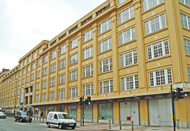
The Stamford Street frontage. The red-coloured building shown to the left in the left-hand image is the former Royal Waterloo Hospital for Children and Women, now a branch of the Schiller University.
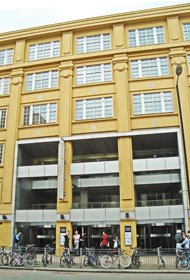
The main entrance in Stamford Street.
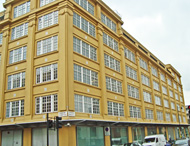
At the corner of Stamford Street and Cornwall Road.
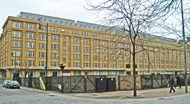

The north frontage along Doon Street, as seen from Upper Ground.

Cornwall House, once the administration block of the new H.M. Stationery Office. The red brick building on the right is the former Royal Waterloo Hospital for Children and Women.
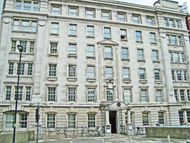
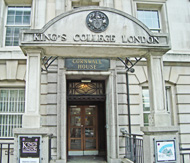
The main entrance to Cornwall House, now the Waterloo Bridge Wing of King's College London.
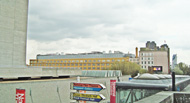
The former Hospital buildings, as seen from Waterloo Bridge. The yellow ochre coloured warehouse is to the east of the pink stuccoed Cornwall House.
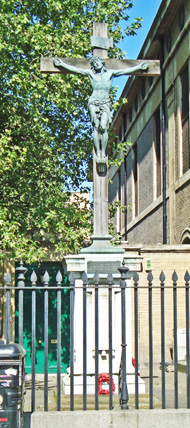
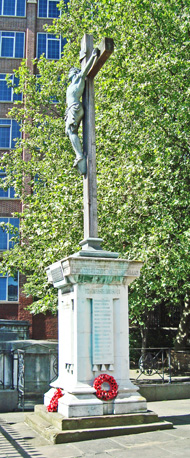
The crucifix donated by the nursing staff of the Hospital, which stands outside St John's Church, just south of the Hospital. The cross and figure (almost life-size) were cast in bronze and mounted on a stone pedestal.

A plaque states: Erected by the Nursing Staff in honour of the patients who died in King George's Hospital, H.M. Stationery Office, Stamford Street, used as a military hospital during the war"
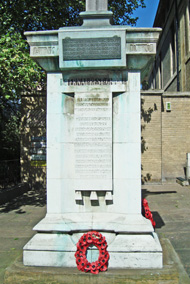
Under the plaque is a statement that a parchment roll listing all the names of those who died at the Hospital has been placed in the church records. The names of those who were parishioners of St John's Church are inscribed on the remaining three sides of the memorial.
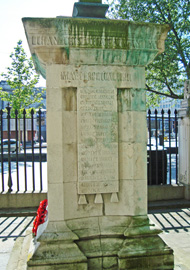
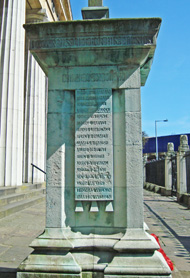
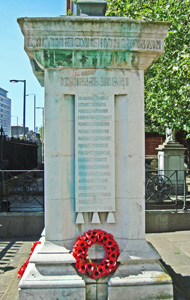
The inscriptions running around all sides of the monument read:
"Greater love hath no man than this, that a man lay down his life for his friends"
"Eternal Rest grant to then, O Lord, and let perpetual light shine upon them"
"In memory of those who have given their lives for their country".

St John's Church, Waterloo Road.
The crucifix can just be discerned to the left of the image, in front of the trees.
(Author unstated) 1914 Care of the wounded. British Journal of Nursing, 28th November, 428.
(Author unstated) 1914 The care of the wounded. British Journal of Nursing, 12th December, 469.
(Author unstated) 1915 Care of the wounded. British Journal of Nursing, 2nd January, 10.
(Author unstated) 1915 Care of the wounded. British Journal of Nursing, 22nd January, 441.
(Author unstated) 1915 Nursing and the war. British Journal of Nursing, 6th February, 109.
(Author unstated) 1915 Nursing and the war. British Journal of Nursing, 6th March, 187-188.
(Author unstated) 1915 Care of the wounded. British Journal of Nursing, 22nd May, 441.
(Author unstated) 1915 King George Hospital. British Journal of Nursing, 29th May, 465.
(Author unstated) 1915 The care of the wounded. British Journal of Nursing, 5th June, 486.
(Author unstated) 1915 Care of the wounded. British Journal of Nursing, 12th June, 508.
(Author unstated) 1915 The care of the wounded. British Journal of Nursing, 19th June, 524.
(Author unstated) 1915 The King George Hospital. British Journal of Nursing, 10th July, 33-34.
(Author unstated) 1915 Care of the wounded. British Journal of Nursing, 25th September, 254.
(Author unstated) 1916 Care of the wounded. British Journal of Nursing, 30th December, 251.
(Author unstated) 1917 Official News. The Red Cross 4, 71.
(Author unstated) 1917 Nursing and the war. British Journal of Nursing, 29th December, 427.
(Author unstated) 1915 The King George Hospital. British Medical Journal 2 (2815), 1043.
(Author unstated) 1915 King George Hospital. British Medical Journal 1 (2834), 740.
(Author unstated) 1915 The King George Hospital, London. British Medical Journal 2 (2844), 29.
(Author unstated) 1915 The King George Hospital, London. British Medical Journal 1 (2837), 866.
(Author unstated) 1915 The King George Hospital. British Medical Journal 1 (2838), 909.
(Author unstated) 1915 The King George Hospital. British Medical Journal 1 (2839), 947.
(Author unstated) 1915 The King George Hospital, London. British Medical Journal 2 (2844), 29.
Farrant DS 1997 The Queen Alexandra Hospital Home. A History. Chichester, Phillimore.
http://1914-1918.invisionzone.com
http://rcnarchive.rcn.org.uk
www.british-history.ac.uk
Return to home page